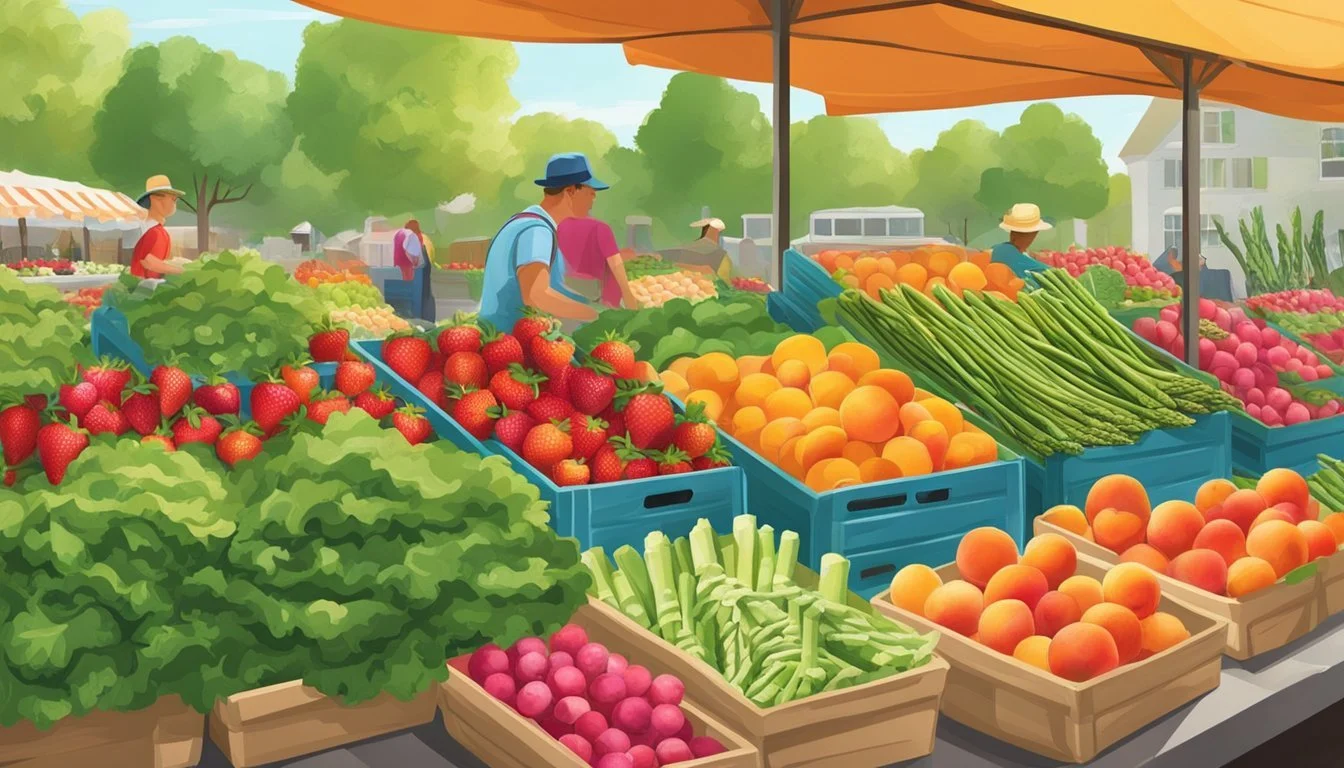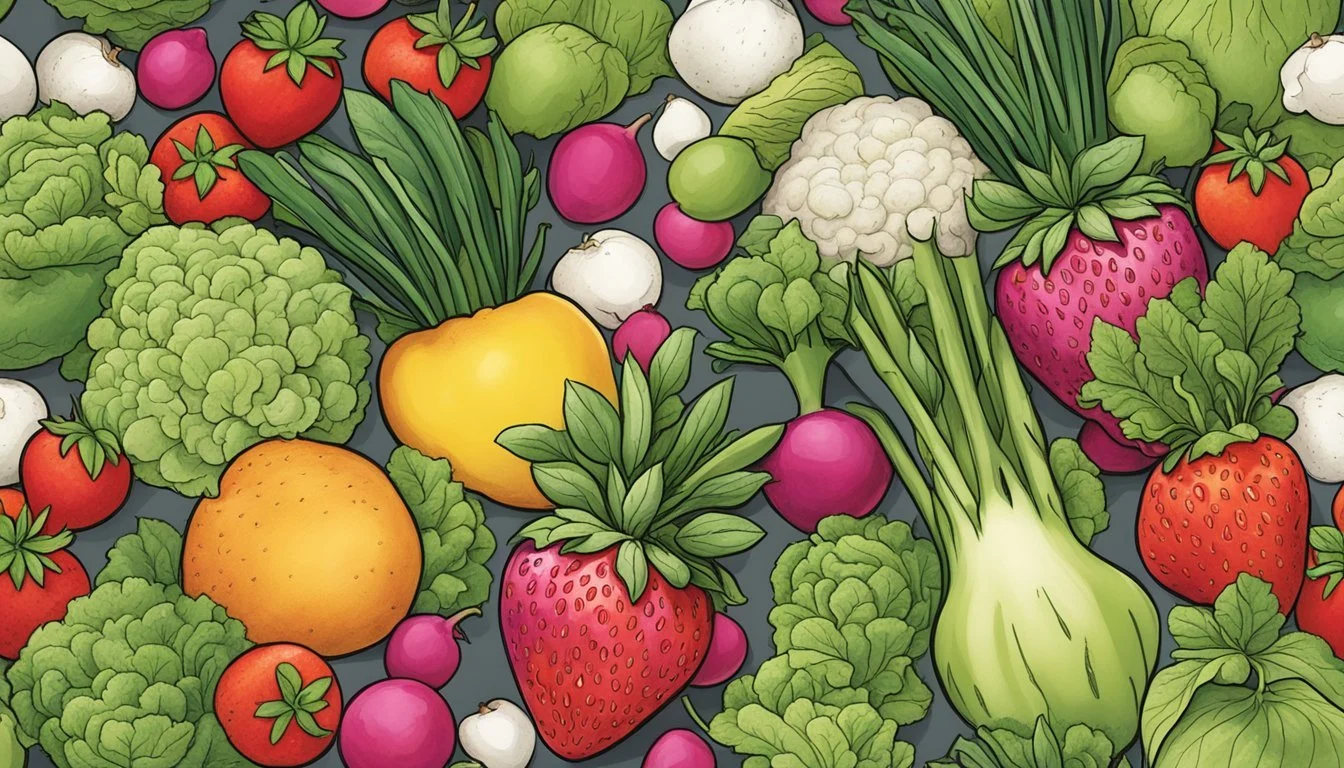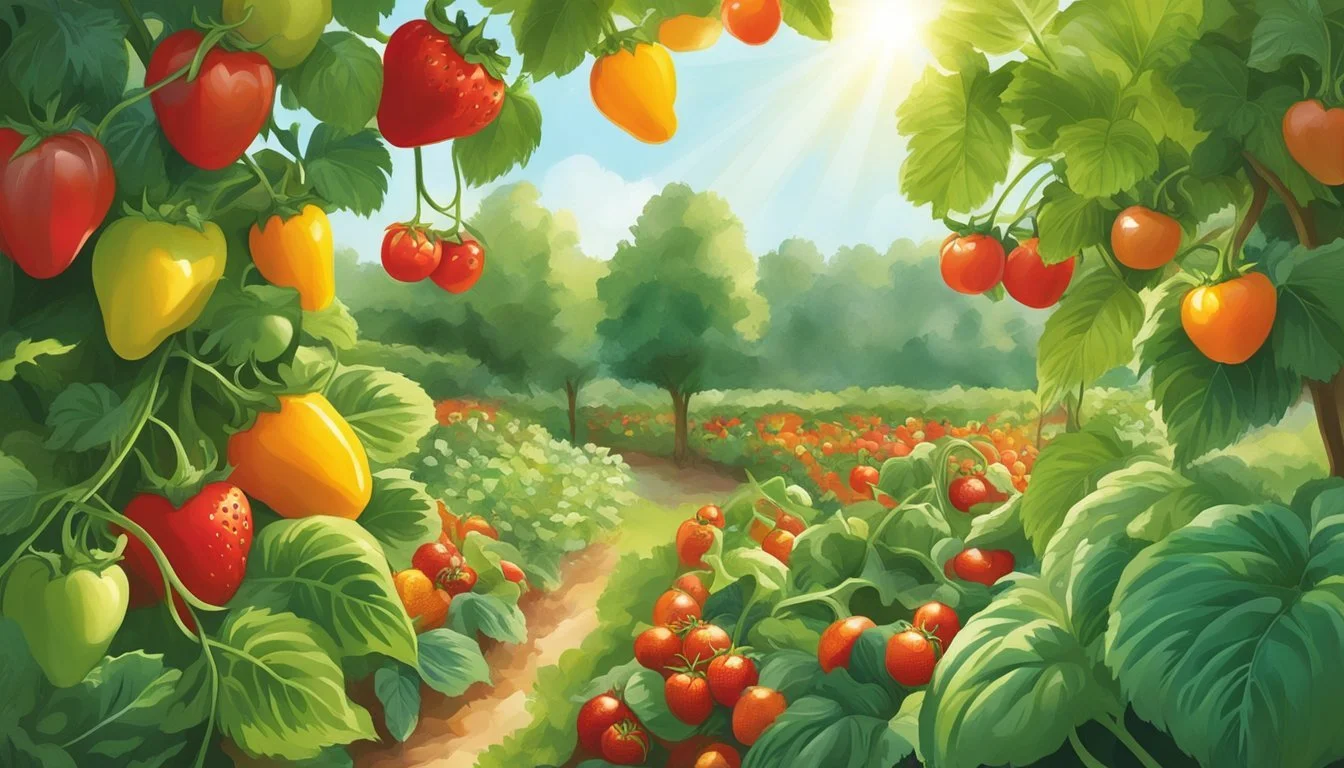Arkansas Seasonal Fruit & Vegetables in April
Your Fresh Produce Guide
This Article is Part of our Arkansas Seasonal Fruit & Veg Calendar
April in Arkansas ushers in a bountiful period for fresh produce, with a variety of fruits and vegetables reaching their peak growing season. As the last remnants of winter's chill give way to the mild warmth of spring, farmers' markets and local grocery stores begin to showcase the state's agricultural offerings. The emphasis on freshness is paramount during this time, as the produce available is not only locally sourced but also harvested at optimal ripeness, offering superior flavor and nutritional value.
Seasonal produce in Arkansas during April encompasses both the last of the cool-weather crops and the beginning of the warmer-weather varieties. This bridge between seasons allows for a unique combination of produce on the Arkansas table. Staples like leafy greens continue to thrive, while the soil begins to yield the first of its herbs and root vegetables. The increased daylight and changing temperatures work in concert to support the growth of an array of produce well-suited for springtime harvests and culinary creations.
Understanding Arkansas' Growing Season
Arkansas' climate offers a generous growing season that shifts through varied conditions from spring to winter. Gardeners and farmers carefully watch these changes to optimize their yields.
Spring in Arkansas
Spring in Arkansas usually brings warmer temperatures and ample rainfall, creating ideal conditions for a multitude of crops. This season is the starting signal for planting cold-hardy vegetables that can withstand the last frost days. Spring also means preparing for the transition towards the consistently warmer weather of summer.
Typical Spring Crops:
Leafy greens (lettuce, spinach (What wine goes well with spinach?))
Root vegetables (radishes, carrots)
Cruciferous vegetables (broccoli, cabbage)
April's Seasonal Shift
As April unfolds, Arkansas experiences a distinctive seasonal shift that marks the advent of true springtime. It is a crucial month for planting and growing a variety of fruits and vegetables, gearing up toward the peak production of summer months like July.
Planting in April:
Fruits: strawberries, blueberries
Vegetables: tomatoes, peppers, cucumbers (how long do cucumbers last?)
One must be aware that April's weather can still bring late frosts, and precautions should be taken to protect tender plants. The adept gardener or farmer in Arkansas takes advantage of April's mild temperatures to establish a garden that will flourish through summer and into fall, with some crops even extending their productivity into the cooler months of winter.
Seasonal Fruits and Vegetables in April
Arkansas showcases a variety of fresh fruits and vegetables come April, with strawberries beginning to peak and a range of garden vegetables becoming available for harvest.
April's Fruit Highlights
Strawberries: April marks the start of the strawberry season in Arkansas. These berries are known for their sweet flavor and are ideal for fresh eating, jams, and desserts.
Apples and Pears: While not at the peak of their season, some late varieties of apples and pears may still be available in Arkansas markets, primarily as stored crops from the previous fall harvest.
April's Vegetable Bounty
Leafy Greens: A variety of leafy greens like spinach and kale thrive in the cool April weather, offering a crisp addition to salads and cooked dishes.
Root Vegetables: Carrots and beets continue to be harvested, providing earthy flavors and vibrant colors to the spring table.
By emphasizing locally available produce, Arkansas residents and visitors can enjoy these seasonal offerings at their freshest and support the local agriculture community.
Health and Nutritional Value
Consuming fruits and vegetables in their peak season can lead to enhanced flavor and maximized nutrient intake. These produce items are often at their freshest, providing a higher concentration of vitamins and minerals.
Benefits of Seasonal Produce
Seasonal produce offers a plethora of health advantages as they typically contain more nutrients than out-of-season fruits and vegetables. They are harvested at the peak of their freshness, ensuring that they have a higher level of antioxidants and phytonutrients. These compounds are known for their role in preventing diseases and contributing to overall health. Moreover, seasonal fruits and vegetables, due to their natural ripening process, usually have a richer and more vibrant flavor profile.
Nutritional Profiles of April Produce
Arkansas's April produce brings a variety of fruits and vegetables with distinct nutritional profiles. Below are key items with their associated vitamins and minerals:
Asparagus (how long does asparagus last?)
Vitamins: Rich in Vitamin K, C, and A.
Minerals: Good source of folate and iron.
Beets
Vitamins: Contain B vitamins and Vitamin C.
Minerals: High in fiber, potassium, and magnesium.
These produce items contribute to health by improving immune function, aiding in blood health, and supporting digestive health. The fiber content is beneficial for digestive system, while the vitamins and minerals support a wide range of bodily functions, including maintaining healthy skin and bones, and protecting against certain diseases.
Selecting and Storing Tips
Selecting produce at peak freshness and storing it correctly are crucial for maintaining flavour and extending the shelf life of fruits and vegetables. This guide offers clear strategies to ensure that April’s seasonal produce in Arkansas stays fresh from the market to your table.
Ensuring Maximum Freshness
When selecting fruits and vegetables such as tomatoes, peppers, eggplant (What wine goes well with eggplant?), squash, melons, and cucumbers, one should look for vibrant, uniform color and a firm texture. For leafy greens like spinach, lettuce, and kale, freshness is indicated by crisp, brightly colored leaves free from wilting or yellowing. Avoid produce with bruises or blemishes, as these can quickly lead to spoilage.
Storage Recommendations
Proper storage is essential to retain the freshness and extend the shelf life of your produce. Here's how to store some of Arkansas's April vegetables and fruits correctly:
Tomatoes: Store at room temperature away from direct sunlight until they ripen, after which they can be moved to the refrigerator to slow down the ripening process.
Peppers and Eggplants: Keep in the vegetable crisper drawer of the refrigerator in plastic bags.
Squash and Cucumbers: Best stored in plastic bags within the refrigerator's crisper drawer; however, they should be consumed within a week for optimal freshness.
Leafy Greens (Spinach, Lettuce, Kale): Wrap in a paper towel to absorb excess moisture and store in a plastic bag in the crisper section of the refrigerator.
Melons: Store uncut melons at room temperature. Once cut, wrap in cling film and store in the refrigerator.
Root Crops (Carrots, Beets): Remove any tops, place in plastic bags, and store in the crisper drawer of the refrigerator to prevent moisture loss and wilting.
The right selection and proper storage methods can greatly affect the quality and enjoyability of fresh produce, ensuring that they remain delicious and nutritious until ready for consumption.
Preparing Seasonal Dishes
April in Arkansas brings a bounty of fresh produce to the table, providing a great opportunity for home chefs to explore the vibrant flavors of the season. Whether one is aiming to create light salads or hearty pastas, the key lies in using simple, fresh ingredients and appropriate cooking techniques to enhance their natural tastes.
Simple and Flavorful Recipes
When incorporating April's seasonal produce, one should consider recipes that allow the natural flavors to shine. Here are a few suggestions:
Salads: Fresh leafy greens like dandelion greens can be tossed in a vibrant salad, accented with thinly sliced radishes and a lemon vinaigrette.
Pesto: Spring garlic and early carrots bring a fresh twist to traditional pesto, which can be used as a pasta sauce or a spread for sandwiches.
Pasta: Asparagus and snap peas can be lightly sautéed and added to a creamy pasta dish to create a satisfying yet fresh meal.
Cooking Techniques for April Produce
The cooking methods one employs can greatly enhance the natural flavors of April's fruits and vegetables:
Roasting: Roasting can intensify the inherent sweetness of root vegetables and fiddlehead ferns.
Blanching: Tender vegetables like asparagus and ramps benefit from blanching, which preserves their color and texture, making them bright additions to any dish.
Raw: Some April produce, such as young carrots and radishes, are best enjoyed raw, providing a crisp texture and a peppery punch to salads and slaws.
Gardening and Harvesting Tips
In Arkansas, April presents an opportune time for gardeners to cultivate and harvest a variety of fruits and vegetables. Proper techniques are essential for a bountiful yield.
Growing Your Own Produce
In April's temperate climate, Arkansas gardeners have the chance to grow a wide array of crops. It is important to plant vegetables that thrive in the full sunlight as the days lengthen. Tomatoes, corn, peppers, cucumbers, and melons typically require significant sunlight to flourish. Gardeners should ensure these plants receive at least six to eight hours of direct sunlight daily.
Leafy vegetables such as cabbage, broccoli, and cauliflower are more forgiving and can perform well with some shade, making them versatile for different garden spots. It's also advantageous to start with high-quality seeds or transplants and follow the recommended planting schedule for Arkansas's USDA plant hardiness zones 6-8.
Here is a brief guide to what could be planted during this month:
Tomatoes: Start in trays 6 to 8 weeks before the last frost.
Cucumbers: Plant seeds indoors or directly in the garden after the last frost.
Peppers: Similar to tomatoes, begin in trays well before transplanting outdoors.
In terms of maintenance, utilize a balance of water, nutrient-rich soil, and proper spacing to support plant health and discourage common garden pests.
Harvest Tips for Home Gardeners
When harvesting, knowing the right time is as critical as the growing process itself. Vegetables like green beans and cucumbers typically have a short period from flowering to harvest; they should be picked while firm and before they overripen to ensure the best flavor and texture.
For root crops, it's important they are harvested before the heat of summer sets in, as excessive heat can cause them to become woody or bitter. Harvesting in the early morning when the temperatures are cooler can also assist in maintaining the produce's freshness and can reduce the stress on the plants.
Here's a concise harvest guide for each plant:
Tomatoes: Harvest when evenly ripe and full-colored.
Cucumbers: Pick when bright green and firm to the touch.
Green Beans: Collect while they are still slim and before the seeds inside bulge.
Lastly, consistent monitoring for insects and disease is key in low-maintenance garden care, allowing for proactive treatment and reducing potential widespread damage to the crop.
Arkansas Produce Calendar
Arkansas offers a diverse array of fresh produce throughout the year with each month heralding the availability of different seasonal fruits and vegetables. The calendar below serves as a guide to what's typically in-season during April and what consumers can anticipate as the growing season progresses into May.
Monthly Guide to Harvest
In April, Arkansas's rich soils and increasingly warm weather cultivate a variety of produce. Commonly, the following are harvested during this month:
Strawberries: Coming into season, they are a highlight of April's harvest.
Greens (such as spinach and lettuce): These continue to thrive and are readily available.
Asparagus: April marks the peak season for asparagus, offering its fresh shoots.
Carrots: Usually sown earlier, carrots are now ready for harvest.
Fruit Vegetables Strawberries Asparagus Greens (lettuce, spinach) Carrots
What to Look Forward to in May
Looking towards May, Arkansas's produce variety begins to broaden significantly. Consumers can expect to find:
Berries (blueberries, blackberries): The berry season starts, beckoning with its tart and sweet flavors.
Peaches: The first juicy peaches of the year start to appear in late May.
Tomatoes: These start to become more plentiful as the weather warms up.
While not in season until September, it's worth noting that apples and pumpkins will be among the fruitful bounty available later in the year, aligning with the typical harvest calendar for Arkansas.
Local Farms and Markets
In April, Arkansas's local farms and markets are abundant with fresh produce. Here, one can experience the convergence of community, agriculture, and commerce.
Finding Farmers Markets
Farmers markets in Arkansas serve as the hub for local produce. They provide a platform for residents and visitors to find a variety of fruits and vegetables harvested in the state. A comprehensive map of farmers markets can be accessed through state resources, ensuring that fresh, seasonal goods are just a short drive away. These markets typically offer an extensive selection of the season's best directly from the farms.
Bernice Garden Farmers Market - Open Sundays, 10 a.m. to 2 p.m.
Holland Bottom Farm, LLC - Offers a farm to table experience with a wide range of fresh produce.
Supporting Local Agriculture
When consumers purchase directly from local farms and markets in Arkansas, they bolster the state's agricultural economy. The act of buying local not only supports Arkansas's farming families but also ensures the freshness of produce. Plus, engaging with local farms allows consumers to understand where and how their food is grown.
Support Local: Buying at farmers markets or directly from farms.
Local Farms: Farms like Holland Bottom Farm, LLC, have been operating for nearly 40 years and offer produce during the growing season.
By visiting farmers markets and patronizing local farms, individuals contribute to sustaining the state's agricultural heritage while enjoying the freshest fruits and vegetables that Arkansas has to offer.
Digital Resources for Arkansas Produce
Arkansans seeking information on seasonal fruits and vegetables have a wealth of digital resources at their fingertips. Online platforms provide updated details on what’s currently in season and where to find the freshest produce. For instance, Agriculture websites specific to Arkansas frequently post harvest calendars that guide consumers and farmers alike through the various growing seasons.
Those interested in visual content can turn to Pinterest, where boards are often dedicated to Arkansas produce, featuring images of ripe fruits and vegetables, accompanied by tips on harvesting and preparation. This social media platform allows users to visually explore and organize seasonal produce information relevant to the state.
Listeners can tune into agricultural podcasts that discuss trends and tips for growing, harvesting, and consuming local produce. These podcasts frequently feature experts in the field, including local Arkansas farmers and horticulturists, who offer their insights into the state’s agriculture.
Here's a brief overview of what digital resources may offer:
Online Calendars: Monthly guides to what's in season.
Pinterest Boards: Curated images and recipes for Arkansas produce.
Agricultural Podcasts: Discussions on best practices and industry insights.
Through these digital channels, Arkansans are well-equipped to make informed choices about their produce, ensuring that they can enjoy fresh, flavorful, and nutritious fruits and vegetables year-round.









